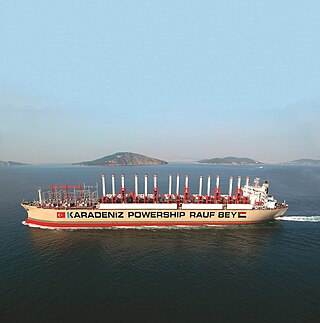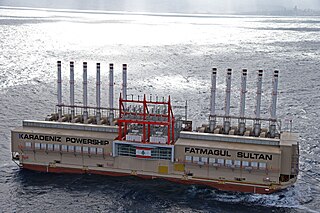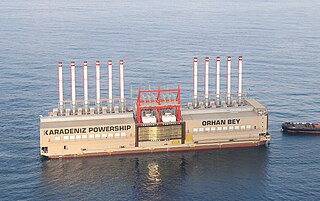
Electricity generation is the process of generating electric power from sources of primary energy. For utilities in the electric power industry, it is the stage prior to its delivery to end users or its storage, using for example, the pumped-storage method.

Nuclear marine propulsion is propulsion of a ship or submarine with heat provided by a nuclear reactor. The power plant heats water to produce steam for a turbine used to turn the ship's propeller through a gearbox or through an electric generator and motor. Nuclear propulsion is used primarily within naval warships such as nuclear submarines and supercarriers. A small number of experimental civil nuclear ships have been built.
The Army Nuclear Power Program (ANPP) was a program of the United States Army to develop small pressurized water and boiling water nuclear power reactors to generate electrical and space-heating energy primarily at remote, relatively inaccessible sites. The ANPP had several accomplishments, but ultimately it was considered to be "a solution in search of a problem." The U.S. Army Engineer Reactors Group managed this program and it was headquartered at Fort Belvoir, Virginia. The program began in 1954 and had effectively terminated by about 1977, with the last class of NPP operators graduating in 1977. Work continued for some time thereafter either for decommissioning of the plants or placing them into SAFSTOR. The current development of small modular reactors has led to a renewed interest in military applications.

Wärtsilä Oyj Abp, trading internationally as Wärtsilä Corporation, is a Finnish company which manufactures and services power sources and other equipment in the marine and energy markets. The core products of Wärtsilä include technologies for the energy sector, including gas, multi-fuel, liquid fuel and biofuel power plants and energy storage systems; and technologies for the marine sector, including cruise ships, ferries, fishing vessels, merchant ships, navy ships, special vessels, tugs, yachts and offshore vessels. Ship design capabilities include ferries, tugs, and vessels for the fishing, merchant, offshore and special segments. Services offerings include online services, underwater services, turbocharger services, and also services for the marine, energy, and oil and gas markets. At the end of December 2022, the company employed 17,500 workers.

Marine propulsion is the mechanism or system used to generate thrust to move a watercraft through water. While paddles and sails are still used on some smaller boats, most modern ships are propelled by mechanical systems consisting of an electric motor or internal combustion engine driving a propeller, or less frequently, in pump-jets, an impeller. Marine engineering is the discipline concerned with the engineering design process of marine propulsion systems.
A load-following power plant, regarded as producing mid-merit or mid-priced electricity, is a power plant that adjusts its power output as demand for electricity fluctuates throughout the day. Load-following plants are typically in between base load and peaking power plants in efficiency, speed of start-up and shut-down, construction cost, cost of electricity and capacity factor.

MH-1A was the first floating nuclear power station. Named Sturgis after General Samuel D. Sturgis, Jr., this pressurized water reactor built in a converted Liberty ship was part of a series of reactors in the US Army Nuclear Power Program, which aimed to develop small nuclear reactors to generate electrical and space-heating energy primarily at remote, relatively inaccessible sites. Its designation stood for mobile, high power. After its first criticality in 1967, MH-1A was towed to the Panama Canal Zone that it supplied with 10 MW of electricity. Its dismantling began in 2014 and was completed in March 2019.

As of April 2020, the energy sector in Senegal has an installed capacity of 1431 megawatts (MW). Energy is produced by private operators and sold to the Senelec energy corporation. According to a 2020 report by the International Energy Agency, Senegal had nearly 70% of the country connected to the national grid. Current government strategies for electrification include investments in off-grid solar and connection to the grid.

The MV Karadeniz Powership Doğan Bey is a Liberia-flagged Powership, a floating power plant, owned and operated by Karpowership. Built 1983 by Mitsui Co. in Ichihara, Chiba, Japan and christened MV Sono, she sailed as a dry cargo ship under various names and flags until in 2010 she was converted into a Powership at the Sedef Shipyard in Tuzla, Turkey. She supplied electricity to the power grid in south-eastern Iraq. Currently, she supplies electricity to Sierra Leone.

Energy in Lebanon is dominated by oil, which represents more than 95% of the primary energy consumed in 2017. The great majority of energy used in the country is imported. The energy market in Lebanon is characterized by sharply rising consumption, and frequent shortages due to dilapidated infrastructure partly destroyed by the civil war that ravaged the country between 1975 and 1990.
The Colombo Port Power Station is a 60-megawatt powership, permanently moored at the Colombo Harbour, in the Western Province of Sri Lanka. After the plant's 15-year license expired in 2015, the Ceylon Electricity Board purchased the powership in a controversial deal. It was previously owned by Colombo Power Private Limited, a 50-50 joint venture by Mitsui Engineering & Shipbuilding and Kawasho Corporation.

The MV Karadeniz Powership Esra Sultan is a Powership, a floating power plant, owned and operated by Karpowership. Built in 2007, it was converted into a Powership in 2015 by Sedef Shipyard in Tuzla, Istanbul, Turkey. She was commissioned to supply electricity to the power grid in Ghana. Currently, she serves in Dakar, Sénégal.

The MV Karadeniz Powership Zeynep Sultan is a Liberia-flagged powership, a floating power plant, owned and operated by Karpowership. Built in 1984 by the Valmet Oy Helsingin Telakka in Vuosaari, Helsinki, Finland and christened MV Pavel Antokolsky, she sailed as a barge carrier under various names and flags until in 2015 she was converted into a Powership at the Sedef Shipyard in Tuzla, Istanbul, Turkey. She is commissioned to supply electricity to the power grid in Amurang, North Sulawesi, Indonesia.

The MV Karadeniz Powership İrem Sultan is a Liberia-flagged Powership, a floating power plant, owned and operated by Karpowership. Built in 1984 by the Fincantieri Marghera Shipyard in Venice, Italy and christened MV Nikolay Markin, she sailed as a barge carrier under various names and flags until in 2014 she was converted into a powership at the Sedef Shipyard in Tuzla, Istanbul, Turkey. She served in Nacala, Mozambique supplying electricity to Mozambique's power grid for land-locked Zambia. Currently, she serves in the Dominican Republic, and is stationed in Santo Domingo.

The MV Karadeniz Powership Rauf Bey is a Liberia-flagged Powership, a floating power plant, owned and operated by Karpowership. Built in 1982 in Brazil and christened MV Gulf Grain, she sailed as a bulk carrier under various names and flags until she was acquired to be converted 2009 into a Powership in Turkey. She served in Basra, Iraq supplying electricity to the power grid there. Currently, she supplies electricity to Sudan.

The MV Karadeniz Powership Fatmagül Sultan is a Liberia-flagged Powership, a floating power plant, owned and operated by Karpowership. Built as a barge, she was converted into a Powership in 2013 at Sedef Shipyard in Tuzla, Istanbul, Turkey. She is commissioned to supply electricity to the power grid in Lebanon.

The MV MV Karadeniz Powership Orhan Bey is a power barge, a floating power plant, owned and operated by Karpowership. She was commissioned in 2013, and initially contracted to supply electricity to the power grid in Lebanon.
Karpowership is a Turkish builder, operator, and owner of a fleet of powerships. Since 2010, 36 powerships have been completed with their total installed capacity exceeding 6,000 MW and further capacity under construction.

The MV Karadeniz Powership Gökhan Bey is Liberia-flagged floating power plant, owned and operated by Karpowership. In 2016, she was solemnly sent off from the Sedef Shipyard in Tuzla, Istanbul, Turkey together with the MV Karadeniz Powership Yasin Bey to Indonesia to supply electricity to the power grid. She has a generation capacity of 125 MW.

The MV Karadeniz Powership Yasin Bey is Liberia-flagged floating power plant, owned and operated by Karpowership. In 2016, she was solemnly sent off from the Sedef Shipyard in Tuzla, Istanbul, Turkey together with the MV Karadeniz Powership Gökhan Bey to Indonesia to supply electricity to the power grid.

















